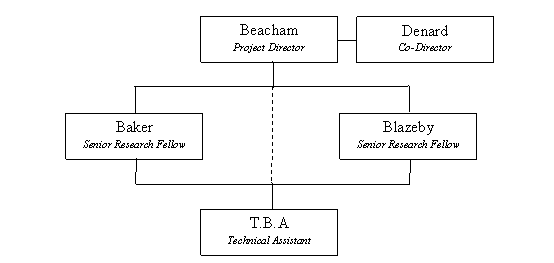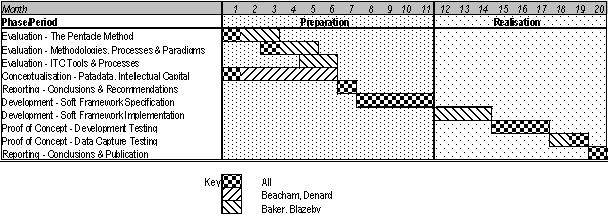Context
Visualisation technologies are increasingly prominent in research across a wide range of arts and humanities disciplines; their importance is evident in the digital research resources of the five subject areas of the AHDS and in proposed extensions of these currently under discussion. Amongst these technologies for new ICT-enabled research leading to new forms of knowledge, one of the most challenging, but potentially rewarding, is 3-dimensional (3D) visualisation. However, research outcomes consequent upon this have not yet begun to be comprehensively exploited, mainly because:
- relatively few researchers have been able to acquire an informed awareness of the nature and benefits of 3D tools and methodologies.
- research outcomes of many 3D visualisation-based projects fail to document in detail how research questions have been systematically addressed through relevant technologies, nor do the outcomes themselves allow other researchers critically to assess them by examining the incremental process of data evaluation, testing of hypothesises, and consequent choices through which the research outcomes were produced.
Modelling spaces and objects is a means of engagement with past and current material culture that is new, distinctive, and demands new methods of “writing” and “reading” research. It differs from traditional approaches in that it requires a systematic and comprehensive investigation and interpretation of the material culture of diverse periods and into the means of modelling such knowledge. In place of the relative transparency that characterises “traditional” research, enabling other scholars to assess information and analytical approaches that produced the conclusions arising from projects, too often visually-based outcomes – which can be seductive and misleading – are presented as “fact”, to be taken “on faith”.
A methodology is needed that offers researchers a window on the process from the selection of 3D technologies, to collection of data, through to final hypothetical model and validation / testing of underlying assumptions. Warwick’s 3D Visualisation Centre1 is well positioned to develop this methodology. Indeed, through its own extensive practice and dialogue with other scholars it has both continuously observed and experienced how the newness of such research has placed us in the anomalous position of being authors of new types of “texts” that we in the scholarly community have not yet fully learnt how to “read.”
Aims/Objectives
The Warwick 3DVC Group has given considerable attention to this problem, particularly with regard to the parameters within which our models are produced and received, and the types of knowledge that “creators” and “readers” will produce in relation to them. We aim not to fashion increasingly realistic virtual objects and environments, but rather to create accurate and usable visualisations of complex datasets making it possible to understand material culture in ways otherwise impossible. Since we are engaged in the creation of relatively new forms of “texts”—e.g. three-dimensional digital objects, images and animations—and in placing them within further “framing” texts—e.g. user-interfaces, hyperlinked structures—with a view to generating and disseminating new knowledge and types of knowledge—i.e. with an explicit, epistemological aim—as an objective we must seek to appreciate the distinctive semantic and stylistic characteristics of these 3D texts and their implications.
The major challenge to potential users is the efficient management of complex 3D research processes. Our project will aim systematically to document and analyse how previous individual projects developed their methods and techniques, enabling future “users” to benefit from a methodology that interconnects related resources and information, and encouraging wider take-up of research deploying 3D visualisation. It will aim to provide future researchers and end-users a comprehensive insight into the creation process and reasoning behind data selection and processing used via a visible audit trail. It will have as a major objective providing the methodology necessary for other researchers to create models with the transparency and transportability essential fully to exploit their valuable research potential. Drawing upon the methodological approaches derived from our own and others’ experience in 3D based research, researchers will be better able to estimate and test hypotheses, acquire visual access to complex data sets, analyse questions amenable to visual investigation, predict and interpret.
We have been in contact with other specialists in the modelling of historic structures 2, who have specifically agreed to work with us observing and documenting their 3D visualisation research and its methodology as part of our work with the aim of incorporating it into our analysis and project outcomes.
We will aim to develop a methodology which makes the choices, decisions, and rationale behind and shaping the 3D research process transparent and easy to interpret The manner in which knowledge is imparted visually will be explicated by documenting (visually and textually) development processes, and capturing the “intellectual capital” vested during all stages of the modelling as choices are identified, decisions made, reflected upon, rejected or revised. The aim of documentation will be to distinguish between the use of “hard fact”, plausible conjecture, intelligent guesses, and alternative hypotheses. It will document “paradata”: records of the activities and materials (themselves properly metadated) tracing the scholarly background work, development phases, debates and arguments engendered in the modelling process, and how these were resolved.
Benefits and interest for the arts and humanities research communities
Material culture – objects, spaces, structures – and their uses are relevant to many arts disciplines, including studies in theatre, film, architecture, archaeology, curatorship, domestic spaces, urban landscapes, analysis of perspective and content of paintings, ritual and spectacle. 3D Visualisation not only examines material culture as it is or was, but also (when appropriate) raises questions such as: how it evolved over time; relationship to other material culture; origin and modifications of elements. The representation and analysis of material culture thus potentially enables researchers to employ complex and diverse data more effectively. 3D reconstruction addresses relevance of data, highlights inconsistencies and identifies new areas for investigation and analysis.
But 3D models often convey to the user a greater sense of realism than is justified by the data actually available to the expert, suggesting a sense of certainty that does not exist in the available dataset. Not only must those who are building models recognise the limits of the representations they construct, but also so must academics and researchers making use of them. Our project will address the danger arts researchers face when using models that do not clearly demonstrate how they are constructed.
In order to examine both the technical and the conceptual components involved in the construction of 3D models a series of best practises must be employed. What is required is a succinctly defined design process that meets the needs of researchers in diverse areas, while enabling an efficient development cycle. It is essential that we control and document the modelling process itself so that those who use the model are fully aware of the assumptions (the thinking) that underpin the model and how and why these were drawn. Only after gaining this understanding can a conceptual framework be built with which to evaluate and benefit from work in this field.
Methods
In this regard is necessary to develop a process to progress through observation, documentation, methodology design, testing. The Warwick team have for several years employed the in-house “Pentacle Method” to develop visualisations. This rapid prototyping approach permits the creation of models in a cyclical path of research, evaluation, modelling and assimilation. Each stage of the incremental development procedure collects, examines, evaluates and selects data options, while maintaining a continuing internal audit and quality control trail.
The Pentacle Method does not exist in the public domain and the intellectual capital vested in the modelling process is locked within project personnel. The project will determine the most appropriate current ICT tools and practices to provide a framework in which intellectual capital can be unlocked to facilitate its communication, examination and dissemination in the wider academic community.
We propose to:
- enhance the Pentacle Method by formalising practices allowing all the research material utilised in the modelling process to be captured, annotated, the rationale behind the components to be explained, to show how decisions were reached, and alternative hypotheses or options rejected during the process of creation and testing.
- enable the transfer of this development methodology, in liaison with the AHRB Methodologies Network, as a resource to others wishing to undertake 3D-based research.
The enhanced method will be consolidated and demonstrated by a proof of concept trial selected for its exemplary and interdisciplinary character. Combining documentation of past and current practice, including both our AHRB and Leverhulme funded projects, as well as the projects of other highly regarded researcher groups, 3D modellers and those who initially evaluated research materials will observe and record the visualisation procedure, to recover and communicate the details of the process by which they were evolved.
Outputs and Dissemination
The project will produce a number of papers both theoretical and practical on the use and value of paradata, the Enhanced Pentacle Method and the technical aspects of a prototype software framework. These will be disseminated though a dedicated web as a project site and as the proof of concept site. Ultimately a collaborative workshop with the AHDS and Methodologies Network is anticipated.
Management and reporting structure.
The overall project direction and theoretical and pedigodigical narrative will be led by Beacham together with Denard as co-director. Baker and Blazeby will enhance their current research practice by the development and implementation of a prototype software framework that supports the processes, theory and philosophy of the Enhanced Pentacle Method.

Project Timetable
The project will be split into two phases Preparation and Realisation totalling 10 and 8 months respectively with an additional month allocated each phase for reporting.

Preparation Phase
This phase is concerned with the preparation of the prototype and defining the nature of paradata and how it can be identified, delimited and captured.
Two streams of research will be conducted
- Critical evaluation of the existing Pentacle Method, its application to previous projects, strengths and weaknesses (month 1-3). This will be supplemented by a review of current extant methods and practices (month 2-5).
- Focusing on paradata, combining reflective post-mortems of previous work, allied projects (notably Kent and Lausanne) and processes that paradata can exploit (month 1-6).
These will be moderated with an investigation into the current ITC tools available to be considered as candidates for the prototype (month 5-6).
Month 7 will be dedicated to assimilating the findings of the two streams, formulating a set of recommendations for the enhancement of the Pentacle Model and outlaying procedures by which the process and paradata can be captured.
Using these recommendations month 8-11 will be spent specifying ITC strategies/processes to fulfil the recommendations and support the method though the prototype.
Realisation Phase
The conclusions from the previous phase will be implemented in the construction of the prototype software (month 12-14). This will be subjected to a complete development cycle proof of concept trial. Three months (15-17) have been allocated for the trials development, with an additional two (18-19) reserved for publication and harvesting of external intellectual capital and paradata.
Month 20 is reserved for analysing outcomes of the proof of concept trial and concluding the project as a whole.
Project Deliverables
See Outputs and dissemination in Section 10a
Monitoring Process
An Advisory Committee will be appointed, composed of two senior academics at the University of Warwick, recognised scholars from allied institutions, Kent and Lausanne. The Advisory Committee will receive progress reports after every six months, and will review work at the end of both phases of the project.
2 including KIDDS (Kent Interactive Digital Design Studio), led by Prof. Baugh at the University of Kent http://www.kent.ac.uk/sdfva/kidds/ and The Virtual Reality Lab at the Swiss Federal Institute of Technology (EPFL) in Lausanne, led by Prof. Daniel Thalman. http://www.eg.org/EG/DL/Conf/EG2002/Labs/45lausannethalmann.pdf This currently leads the EU ERATO Project http://www.at.oersted.dtu.dk/~erato/index.htm and is a partner in EPOCH, the Network of Excellence of which the 3DVC is also a partner. http://www.epoch-net.org/
